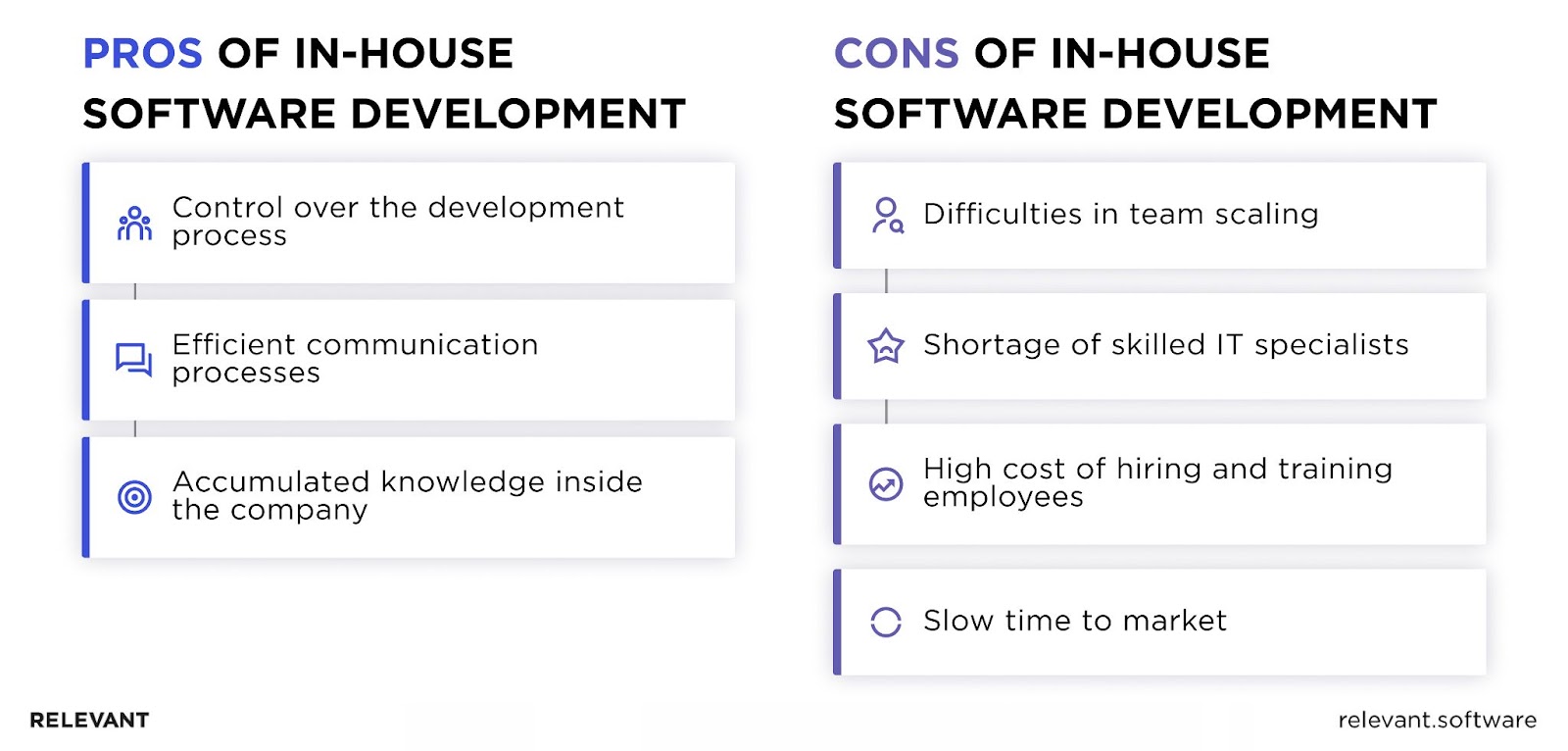In-house vs. Outsourcing Software Development: Detailed Comparison in 2023

Any new software project in the turbulent 2023 will undoubtedly present you with a dilemma: outsource development or stay in-house. While IT outsourcing services can be cheaper and more efficient, in-house development gives more direct control over the process. And these are just the differences that lie on the surface. You will probably need more arguments to lean toward any decision.
To clear things up, in this article, we will compare two models: in-house software development and outsourcing. Once you grasp their essence, pros, and cons, it will be easier to evaluate the situation in your business and choose the most appropriate development model for your project. Let’s look in detail!
In-house Development vs. Outsourcing: What’s the Difference?
Starting, let’s define the terminology. In-house software development means a company develops software internally. Full-time developers work per fixed salary under direct company management, focusing exclusively on the product.

The in-house approach offers full control over the development process, ensuring that the software meets the company’s standards and its intellectual property is protected and confidential. But the company must have an infrastructure with a workspace with all the necessary equipment and software tools to use this model.
Conversely, outsourcing refers to the transfer of specific software development tasks or projects to a third-party provider. This model is actively used by companies that do not have the expertise and resources to build software themselves.
Additionally, outsourcing gives access to a pool of developers with the skills, experience, and domain knowledge needed to accomplish these tasks. That also means cost savings, as businesses pay only for the necessary scope of work and do not maintain a full-time development team.
Now that you are familiar with the two concepts, let’s examine the in-house and outsourcing pros and cons in more detail.
Benefits of Outsourcing Software Development
One thing is indisputable: IT outsourcing is the biggest industry in the world. Global spending on it could hit $519 billion in 2023. According to ISG Research, 92% of Forbes Global 2000 companies use IT outsourcing, and 59% – business process outsourcing. This allows companies to focus on core competencies and eliminate repetitive tasks. But that’s just a piece of the pie. Let’s look closely at each additional benefit.
Access to a wider pool of talent
Every business wants to make development affordable and collaborate with the best in their field. And outsourcing gives this access to a global pool of talent and expertise. You can pick developers with various skills and experience that fully suit your needs. Agree this is more than attractive because behind each successful project will be an experienced team passionate about their work.
Streamlined recruitment process
The recruitment process for an in-house development team can be time-consuming and costly, and you are moving slowly. Outsourcing eliminates the need for this process, as companies can rely on third-party development companies to recruit and select developers. This method allows you to quickly add competent people to the team and save money on hiring and training.
Scaling up and down easily
With outsourcing, companies can quickly and easily increase or decrease the size of their development team depending on their needs. It is especially useful for companies that experience seasonal fluctuations in demand or need to accommodate a sudden increase in workload. Outsourcing makes it possible to quickly bring in additional developers to meet the increased demand without going through a lengthy recruitment process.
Tried and proven delivery processes
Outsourcing companies usually have multiple projects and experience in different areas of development. Thus, they have expertise in product delivery, a huge advantage for any company that decides to outsource its development. It can give companies the confidence that the software will be delivered on time and within the budget, helping to reduce the risk of project failure. Additionally, outsourcing vendors often have access to tools and technologies that may not be available to in-house teams.
Drawbacks of Outsourcing Software Development
To make the choice objective, it is necessary to evaluate the disadvantages of outsourcing IT development (by the way, here are tips on avoiding them).
Less visibility over the development process
One of the drawbacks of outsourcing software development is that companies may have less visibility over the development process. As a result, companies may find it more difficult to keep track of progress and ensure that the development process meets their standards and expectations. To mitigate this, companies must communicate clearly with their outsourcing partner, regularly monitor progress, and establish protocols for reporting and feedback.
Privacy and security concerns
Outsourcing software development involves entrusting a third party with sensitive company information and intellectual property. That can raise privacy and security concerns, as companies may be worried about protecting their data’s security and intellectual property. To mitigate these risks, companies need to choose a reputable outsourcing partner, ensure that proper security measures are in place, and regularly monitor the privacy and security of their information.
Team integration challenges
Another drawback of outsourcing software development is the possible poor integration of the outsourced team into the company’s existing processes and culture. Integration challenges can result in a lack of cohesion between the internal and outsourced teams, leading to misunderstandings and inefficiencies. To avoid this, companies must establish clear communication, collaboration, and feedback protocols and provide ongoing training and support to the outsourced development team.

Outsourcing Software Development Examples
Our company has solid experience in outsourcing and has already completed over 200 projects for companies from 25 countries. Therefore, as examples, we will cite our successful cases of outsourcing development.
Norwegian
One illustration of a productive outsourcing partnership is our work with Norwegian. The company hired us because it decided to migrate two native mobile apps (iOS and Android) to React Native. It was a daunting task with many challenges along the way. But our expertise helped us accomplish this task brilliantly.
Now the application provides a seamless experience regardless of the device used by customers. Norwegian has also been able to lower the number of engineers working on developing Android and iOS apps due to switching to React Native, saving money and reducing the bother of managing two different teams.
My Theory Test app by James May
Another example of how outsourcing can power business capacities is our case of Splink Industries. The company approached us to continue the development of the My Theory Test by James May app, created by another company. The business challenge was legacy code. By dedicating a development team, Relevant has helped the client to refactor and implement new features. Now, we are responsible for the maintenance of all app versions.
As a result, the app is ranked #5 on the App Store in the UK’s education category with a 4.9 ranking from users (the highest of any Theory Test app on the market). Every month 10.000 unique users prepare for the driving theory test, and 1300 DVSA tests are passed with the help of the My Theory Test by James May.
FirstHomeCoach
Client – a UK-based fintech company, hired our team of dedicated developers to bring expertise and a fresh perspective to the development of their SaaS platform, with a focus on customer satisfaction.
After collaborative work, our team provided a solution that guides homebuyers through the home-buying process with expert support, access to educational resources, a virtual assistant, and up-to-date information. With the platform, potential homebuyers can create a personalized plan, analyze costs, and track every stage of the property buying process.
Advantages of In-house Software Development
Now that we’ve covered all the nuances associated with outsourcing, it’s time to explore an alternative approach – in-house development. It has quite a few benefits that are just as relevant today as they were in the pre-outsourcing days:
Control over the development process
With in-house development, companies have direct access to their development team and can quickly and easily monitor progress, address issues, and change the development process as needed. This level of control is essential for companies that must ensure that their development process meets specific standards and expectations.
While having control over the development process can be beneficial, it can also lead to rigid processes and decision-making, which can negatively impact the efficiency of the development process.
Efficient communication processes
In-house software development enables companies to establish efficient communication processes between their development and business teams. With in-house development, there are no barriers to communication, as all team members are located in the same place. The chance of misunderstandings and miscommunications is decreased as a result of more effective teamwork.
While in-house software development can result in efficient communication, it can also lead to a lack of diversity in the development process, leading to a narrow focus and limited exposure to new ideas and technologies.
Accumulated knowledge inside the company
In-house software development means accumulating knowledge and expertise within an organization. Over time, the in-house team can develop a deep understanding of the company’s processes, systems, and culture, leading to more efficient development and a better product.
While having employees with specialized knowledge and expertise is beneficial for the company, it can also limit the company’s ability to adapt to changes in the market or technology. That can result in a lack of diversity in the development process, leading to limited innovation and reduced competitiveness in the industry.
Disadvantages of In-house Software Development
Of course, if in-house development were the ideal solution, outsourcing wouldn’t be as popular as it is now. Here’s a rundown of some of the biggest problems with insourcing:
Difficulties in team scaling
Scaling the team can also be challenging for the in-house team, especially if the company experiences sudden growth or needs to adapt to market changes quickly. It can result in a mismatch between the company’s needs and the resources available, leading to inefficiencies and delays in the development process.
This aspect is not so important in large companies that lead several projects simultaneously, as you can relocate people between these projects. But scaling your team up and down becomes critical if you are a startup or a small/midsize business.
Shortage of skilled IT specialists
Another disadvantage of in-house software development is the shortage of skilled IT specialists. That can make it difficult for companies to find and retain employees with the right skills and experience in their team, which can negatively impact the quality and efficiency of their development projects.
High cost of hiring and training employees
Having an entire team of the best people in the industry can be a tempting prospect, but only as long as you don’t factor in the overall potential cost. You must invest a lot of time and resources into finding, hiring, training, and perks for in-house employees. When the team idles between projects, you’ll still have to cover their fixed salaries.
Slow time to market
In-house software development can take longer than expected. With staff members at full capacity, developers may need to double up on projects and work overtime to keep up with demand. According to QSM, the average development project takes about one year and requires 11,415 hours of effort. But companies must release their products rapidly to the market in today’s cutthroat business environment or risk losing out to rivals.

In-house Software Development Examples
It usually makes sense to choose an internal model when it comes to the long-term development of one or more large products at the same time and when they are connected to your mission-critical business systems. And, of course, many companies turn to it. We list a few big tech companies with large in-house teams united into big development centers:
Salesforce
Sometimes, business owners want full control over product development if the work involves critical data or corporate secrets. In this case, insourcing is the best choice, as they can track progress daily, quickly resolve problems, and ensure no information leaks outside the company. Perhaps that is why Salesforce, the creator of a first-class CRM system, selected in-house over outsourced software development for its projects.
Netflix
If the software is related to the main purpose of the business, it should probably be built in-house. Netflix is a good example of such a strategy. The company is heavily investing in machine learning and data analysis programs for its user interfaces, which sets Netflix apart from the competition. And since it’s the company’s main platform for delivering movies and shows, Netflix naturally needs full control over it. But even with such an in-house commitment, Netflix never shied away from outsourcing and was able to survive the 2004 recession.
Amazon
As we said, the internal development team better understands the company’s processes, systems, and culture, which is critical for big players like Amazon. However, by staying at home, the company had to invest in developing the technical acumen (that often lacked in-house employees) and invest $700 million to improve their skills.
When is the Outsourced Team Model Suitable?
Outsourcing your development team can be a practical choice in several scenarios. Firstly, outsourcing can be a viable solution if your company needs to quickly scale its development team without investing in additional resources or hiring processes.
Additionally, if your company lacks specific development skills or expertise, outsourcing can provide access to a wider talent pool, enabling your company to benefit from specialized skills and knowledge. It can be ideal for companies with specific projects or one-off development needs requiring an expertise that may not be available in-house. That can be particularly useful for companies operating in niche industries or with complex developmental needs.

Another scenario where outsourcing may be suitable is when your company is looking to launch a product quickly. With outsourcing, your company can benefit from tried and proven delivery processes that can help speed up the development process and bring your product to market faster.
Finally, outsourcing to Eastern Europe can provide a more cost-effective alternative to in-house development if your company is looking for cost-effective development solutions. With outsourcing in top outsourcing destinations like Ukraine, Bulgaria, Romania, and Poland, companies can benefit from lower labor costs, reduced overhead expenses, and a more streamlined development process.
In-house vs. Outsourcing Software Development – Comparison Table
The table below provides a side-by-side comparison of outsourced and in-house development.
| Feature | In-house Development Team | Outsourced Team |
| Cost | Expensive due to overhead and salary | Cost-effective due to geographic differences in rates and a larger talent pool |
| Technology and Resources | Defined resources and tools. Technology is limited to specific projects | Extensive resources, and all types of experts. Hottest technologies |
| Expertise | Narrow and exact | Wider range |
| Recruitment and Hiring | Complex and time-consuming | Addressed by the outsourcing partner |
| Quality | The high quality of product/work | Variable quality |
| Flexibility | Strict procedures, less flexible | Adaptive and more flexible |
| Speed | Steady and gradual | Faster and gradual |
| Management and Communication | Well-established and seamless | Less manageable |
| Security | High | Lower but can be improved with an NDA and similar agreements |
Hybrid Approach: Get the Best of Both Worlds
While the choice between in-house vs. outsourcing can be tricky, the middle ground is available. It is the hybrid strategy that brings the greatest elements of the two business strategies together.
Combining in-house and outsourcing development can provide the perfect solution where an in-house team can handle core tasks while others run by outsourcing. Moreover, you can mix these two models at different stages, giving you freedom of choice and variations.
But how do you decide which jobs to undertake internally and which to outsource? Well, the obvious and best advice is not to outsource activities that you excel at or those that give you a strategic advantage. You definitely shouldn’t outsource any of the core competencies of your business; it makes you too dependent on your suppliers. Instead, outsource functions where you lack experience or flexibility.
Why Should You Partner with Relevant Software for IT Outsourcing?
Software development outsourcing makes sense if a company wants to get the best specialists in its industry at affordable prices. But here, business owners need to approach outsourcing partner choices thoroughly. That is vital for getting the desired result from software development.
And once you’re here, you’ve definitely come to the right place. At Relevant, we’ve provided IT skills and experience to support companies across industries for over nine years. We have developed over 200 software products for clients worldwide, including the US, UK, and Norway. And we are proud that our experts can cover the full scope of IT services, including web and mobile applications development, web design, cloud computing, cybersecurity, DevOps, etc. Our clients appreciate us as reliable and proficient partners.



